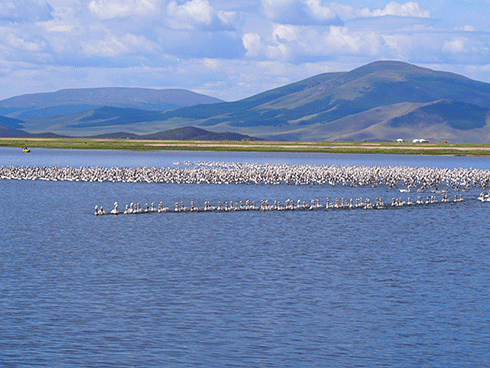
|
Published: 27 January 2015
‘Roller-coasting’ over Himalayas helps birds avoid altitude sickness
An international team of scientists has changed our understanding of how migratory geese cross the highest mountains on Earth, the Himalayas.

|
|
Bar-headed geese on Terkhiin Tsagaan Lake, Mongolia. Credit: UTAS
|
The research, published in the prestigious journal Science, reveals that bar-headed geese (Anser indicus) do not maintain a stable altitude as previously thought but rather fly up and down like a roller coaster, tracking the terrain below.
Led by Dr Charles Bishop of Bangor University, the team included scientists from the UK, Mongolia, Canada, Germany, the USA and Professor Peter Frappell from the University of Tasmania (UTAS).
‘Every year these geese make what is possibly one of the most extreme migrations known as they transverse the high mountains of the Himalayas,’ Professor Frappell said.
‘How they are equipped to fly at these altitudes in freezing temperatures and thin air has been a question that has dogged biologists for decades and led to an abundance of theories about their behaviour and physiology.’
Professor Frappell said until recent technological developments, the birds’ remote habitat has precluded in-depth studies. Most insights have come from captive birds at rest or, more recently, flying in wind tunnels.
For this study, small custom-engineered data loggers allowed the scientists to monitor pressure-derived altitude, body accelerations and the heart rates of the birds during their southern migration from breeding grounds in Mongolia to wintering grounds in south-eastern Tibet or India.
The study revealed that while it was previously assumed the geese would fly to altitudes in excess of 7000 metres and then remain there during their flights, they actually conserved energy by adopting a roller coaster approach.
‘This means the geese were repeatedly shedding hard-won altitude only to have to regain that height later in the journey,’ Professor Frappell said.
‘The birds adopt this roller coaster strategy because the higher they fly, the more difficult flight becomes.’
The decrease in air density associated with high altitude reduces the bird’s ability to produce the lift and thrust required to maintain flight. Wing beat frequency and amplitude needed to increase with altitude, leading to an exponential rise in the estimated energy required for flight.
It is generally more efficient to reduce the overall cost of flying by seeking higher-density air at lower altitudes. To aid their ascent, the birds also occasionally obtained assistance from updrafts of air deflected by the ground (known as orographic lift) and often flew at night when the air was colder and denser.
Professor Frappell said the bar-headed geese had a number of physiological characteristics that made such a high altitude migration possible.
‘Minimising the cost of flight is important at high altitudes where the birds also face the problem of reduced oxygen availability,’ he said.
‘The fact that these birds can fly to these altitudes with minimal acclimation is impressive when you consider that humans who travel to these altitudes, even while resting, could suffer dizziness, altitude sickness or high altitude pulmonary oedema.
‘A better understanding of the physiology of animals adapted to high altitude conditions could help people cope with altitude or respiratory diseases.’
At sea level, air comprises 21 per cent oxygen, at 5500 m the amount of oxygen is equivalent to 10.5 per cent oxygen at sea level, and near the top of Mt Everest the amount of oxygen is equivalent to 7 per cent oxygen at sea level.
The team has previously shown that bar-headed geese have lungs that favour a high diffusion of oxygen, haemoglobin with a high affinity for oxygen, a relatively large heart that allows for increased cardiac output, and muscles that perform very efficiently. This improves oxygen extraction and delivery at high altitudes.
‘Given that more than 140 million people live at high altitude (defined at being more than 2400 m; this is higher than Mt Kosciuszko) and are at risk of chronic pulmonary hypertension, the more we understand the fundamentals of the oxygen delivery process the better chance we have of developing treatments to improve the quality of life for people who live in these environments.’
Source: UTAS



